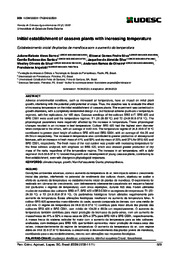Initial establishment of cassava plants with increasing temperature.
Initial establishment of cassava plants with increasing temperature.
Author(s): BARROS, J. R. A.; SILVA, E. G. F.; SANTOS, C. B. dos; SILVA, J. de A.; SILVA, W. O. da; OLIVEIRA, A. R. de; ANGELOTTI, F.
Summary: Adverse environmental conditions, such as increased air temperature, have an impact on initial plant growth, interfering with the potential yield potential ofcrops. Thus, the objective was to evaluate the effect of increasing temperature on the initial establishment of cassava plants. The experiment was carried out in growth chambers, with a completely randomized design in a 3x2 factorial scheme (cultivars x temperature regimes), with five replications, for 165 days. Cassava seedlings of the cultivars BRS 417, BRS 420 and BRS CS01 were used and the temperature regimes: T1 (20-26-33 °C) and T2 (24.8-30.8-37.8 °C). The physiological parameters were negatively affected by the increase in temperature. These physiological changes resulted in an increase in leaf temperature. Cultivar BRS 420 had the highest stem diameter when compared to the others, with an average of 4.63 mm. The temperature regime of 24.8-30.8-37.8 °C contributed to greater plant height of cultivars BRS 420 and BRS CS01, with an average of 104.28 and 89.54 cm respectively. The increase in temperature also contributed to greater production of aboveground biomass, with an increase in fresh mass of 41% and 52% and dry mass of 20% and 37% for BRS 420 and BRS CS01, respectively. The fresh mass of the root system was greater with increasing temperature for the three cultivars analyzed, with emphasis on BRS 420, which also showed greater production of dry mass of the roots, regardless of the temperature regime. The increase in air temperature, with a daily regime of 24.8-30.8-37.8 °C favored the growth and development of young cassava plants, contributing to their establishment, even with changes in physiological responses
Publication year: 2023
Types of publication: Journal article
Unit: Embrapa Semi-arid Region
Observation
Some of Embrapa's publications are published as ePub files. To read them, use or download one of the following free software options to your computer or mobile device. Android: Google Play Books; IOS: iBooks; Windows and Linux: Calibre.
Access other publications
Access the Agricultural Research Database (BDPA) to consult Embrapa's full library collection and records.
Visit Embrapa Bookstore to purchase books and other publications sold by Embrapa.

